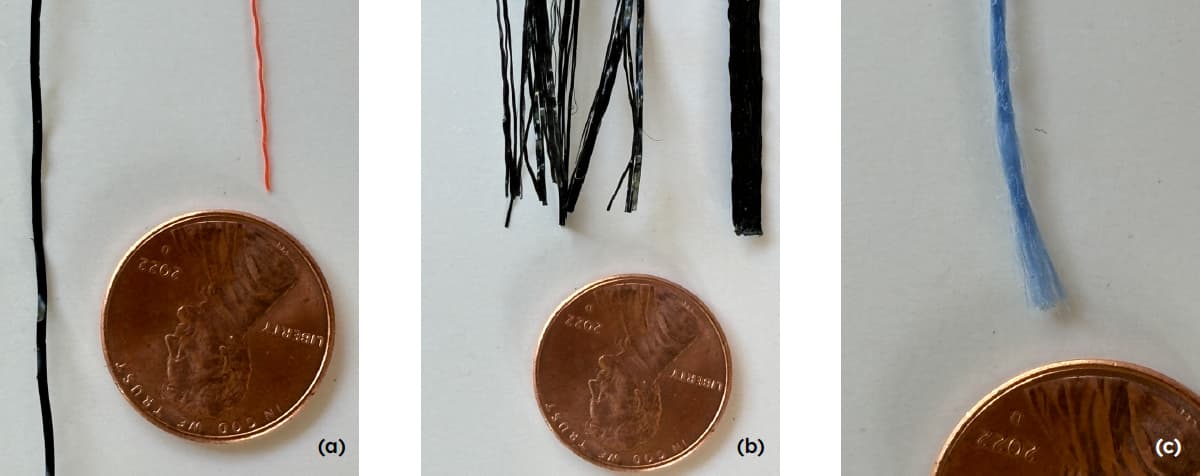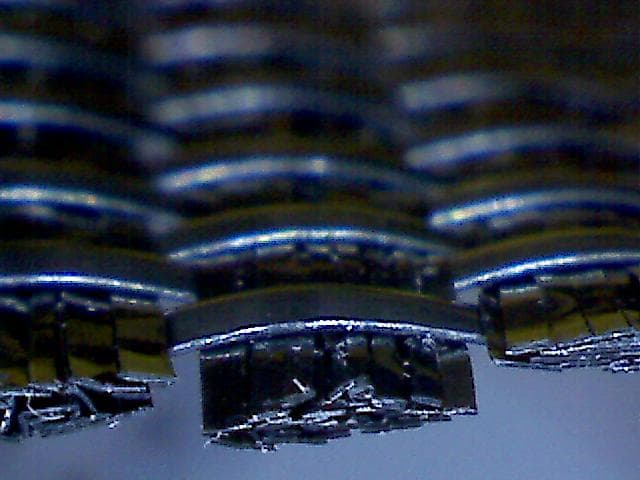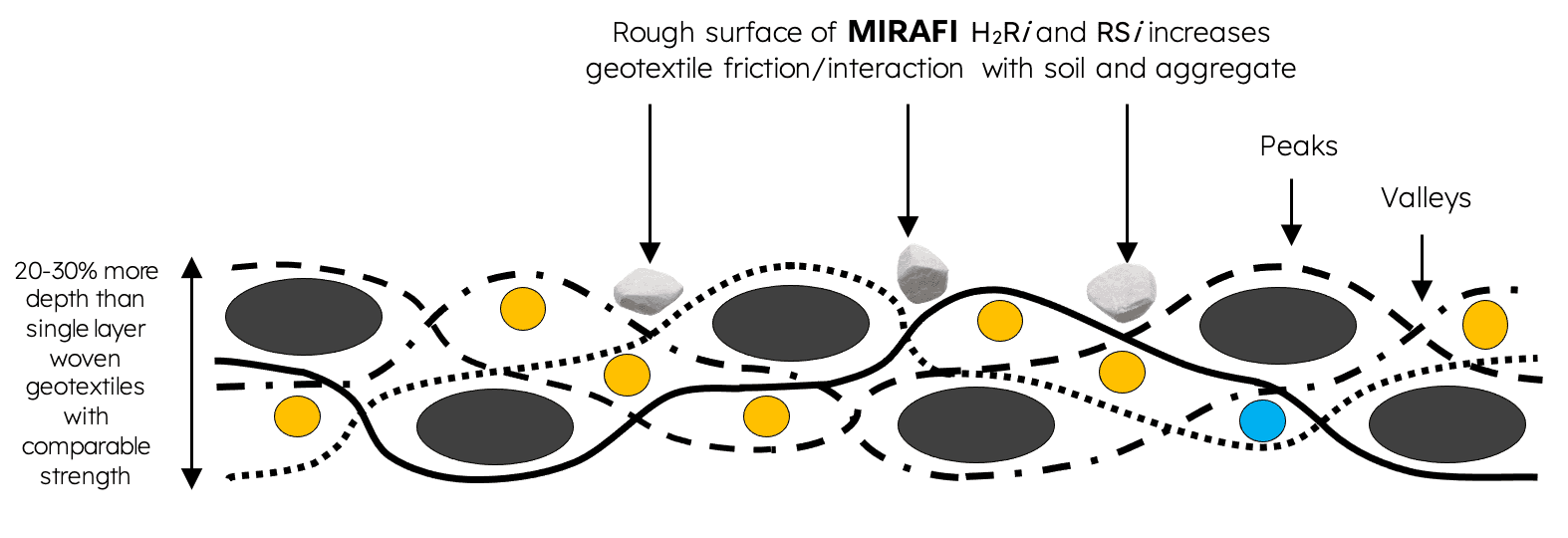>
Products
Technical note
3 Min read
>
3 Min read
MIRAFI® RSi and H2Ri woven geotextiles utilize 3 different types of yarns (Figure 1) to optimize performance of the patented double layer weaving technology with wicking that creates a truly uniquely performing geotextile.

The original woven geotextiles utilized flat slitted film (slit film) woven together to construct a single layer fabric that was very smooth, almost impermeable and low performance. Today, most woven geotextiles still utilize this single layer construction without wicking fibers, but use monofilaments for improved permeability. Unfortunately, this type of construction still creates a very smooth surface with little soil interaction (see Figures 2 and 3).

MIRAFI H2Ri , RS380i, and RS580i are innovative geotextiles that are constructed utilizing monofilament, high modulus fibrillated, and wicking yarns (see Figure 1) to create a patented double-layer weave pattern with wicking. This design arranges the yarns to create a corrugated weft yarn set adjacent to a stuffer pick (see Figures 4, 5, and 6). Specifically, MIRAFI RS580i and RS380i include wicking fibers in some stuffer picks (see Figure 5), while MIRAFI H2Ri uses wicking fibers in all stuffer picks (see Figure 6). Although this terminology may be unfamiliar to those outside the technical textile industry, it underscores the unique properties of the MIRAFI H2Ri and RSi-Series, which are crucial for enhanced geotextile performance, providing more than three times the surface area of typical woven geotextiles.

Figure 3: Cross section of a typical woven geotextile. In contrast to MIRAFI RS380i and RS580i, this structure creates a smoother surface with less opportunity for soil interaction/friction

Figure 4: MIRAFI RS580i cross-sectional image illustrating stuffer pick and weft yarn set

Figure 5: Cross sectional diagram and photo of MIRAFI RS380i and RS580i, illustrating wicking yarn and orange monofilament yarn placement

Figure 6: Cross sectional diagram and photo of MIRAFI H2Ri structure, illustrating wicking yarn placement
The unique construction of MIRAFI RSi and H2Ri creates a surface on the geotextile with larger “peaks” and “valleys” at the yarn cross over points than a typical single layer geotextile (Figure 7). For example, MIRAFI H2Ri, RS380i and RS580i have 8 to 9 weft yarns sets per square inch of fabric, resulting in 8 to 9 deep corrugations (“valleys”) in the fabric every square inch. The larger density of deep corrugations results in a combination of higher surface area and higher in plane friction, resulting in greater shear resistance with a wider range of soil /rock types compared to a typical single layer woven geotextile (Figure 2 and 3). In a recent Study by Louisiana Transportation Research Center, LTRC1, the improved friction characteristics of the MIRAFI RSi-Series were found to provide high lateral restraint of the base course at low strain levels.

MIRAFI RSi and H2Ri geotextiles patented double layer weave technology also creates a geotextile with better water flow and more resistance to clogging. The unique woven structure of MIRAFI RSi and H2Ri contains “stacked” multi cross-sectional yarns, which create more depth (20–30% increase) in the structure with a three-dimensional aspect (Figure 7). The increased depth creates a highly tortuous path (Figure 8) that improves long-term waterflow by increasing clogging resistance, while retaining finer soil particle sizes compared to a typical single layer geotextile (Figure 9).

Figure 8: Cross sectional diagram of MIRAFI RS380i, RS580i, and H2Ri structure, illustrating a higher number of interstices within the fabric structure, creating multiple channels that provide a more tortuous path for increased waterflow with less blinding/clogging

Figure 9: Cross sectional diagram of a typical woven geotextile with single-layer construction. This structure provides a straight, less tortuous path for waterflow through the geotextile
References: 1. Abu-Farsakh, M.Y. (2019), Final Report 603 Accelerated Load Testing of Geosynthetic Base Reinforced/ Stabilized Unpaved & Pavement Test Sections, Louisiana Transportation Research Center, LA.
Notes: 1. U.S. Patent 8,594,054; 12,123,113; 8,333,220; 8,598,054; 10,669,650; 7,874,767; 8,070,395
Figure 1: The unique patented construction of MIRAFI RSi and H2Ri geotextiles utilize 3 different types of yarns to optimize performance: (a) orange and black monofilament yarns, (b) high modulus fibrillated yarn (pulled open on the left to show fibrillations), (c) blue wicking yarn
Figure 2: Typical woven geotextile with single layer construction
Figure 7: Cross sectional diagram of MIRAFI RS380i/RS580i structure, illustrating patented corrugated weft yarn sets. This structure creates “Peaks” and “Valleys” in fabric surface. The double-layer construction increases soil friction/interaction for improved lateral restraint at low strain levels